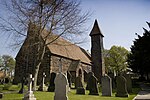Chat Moss is a large area of peat bog that makes up part of the City of Salford, Metropolitan Borough of Wigan and Trafford in Greater Manchester, England. North of the Manchester Ship Canal and River Mersey, 5 miles (8 km) to the west of Manchester, it occupies an area of about 10.6 square miles (27.5 km2).
As it might be recognised today, Chat Moss is thought to be about 7,000 years old, but peat development seems to have begun there with the ending of the last ice age, about 10,000 years ago. The depth of peat ranges from 24 to 30 feet (7 to 9 m). A great deal of reclamation work has been carried out, particularly during the 19th century, but a large-scale network of drainage channels is still required to keep the land from reverting to bog. In 1958 workers extracting peat discovered the severed head of what is believed to be a Romano-British Celt, possibly a sacrificial victim, in the eastern part of the bog near Worsley.
Much of Chat Moss is now prime agricultural land, although farming in the area is in decline. A 228-acre (92 ha) area of Chat Moss, notified as Astley and Bedford Mosses, was designated a Site of Special Scientific Interest in 1989. Along with nearby Risley Moss and Holcroft Moss, Astley and Bedford Mosses has also been designated as a European Union Special Area of Conservation, known as Manchester Mosses.
Chat Moss threatened the completion of the Liverpool and Manchester Railway, until George Stephenson, with advice from East Anglian marshland specialist Robert Stannard, succeeded in constructing a railway line through it in 1829; his solution was to "float" the line on a bed of bound heather and branches topped with tar and covered with rubble stone. The M62 motorway, completed in 1976, crosses the bog, to the north of Irlam. Also the A580 crosses the bog, forming Leigh, Lowton and Astley's (Wigan MBC)'s boundary with Warrington, Culcheth and Glazebury, Croft, and Kenyon.







